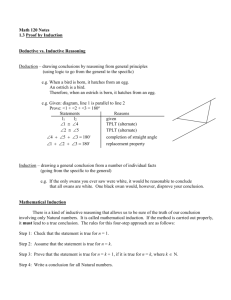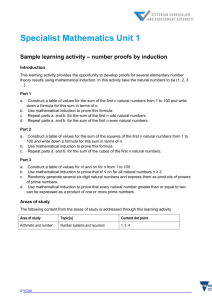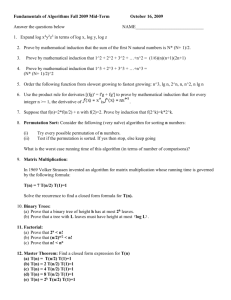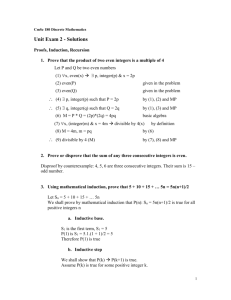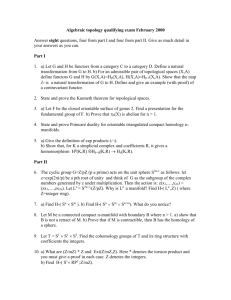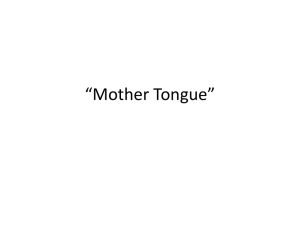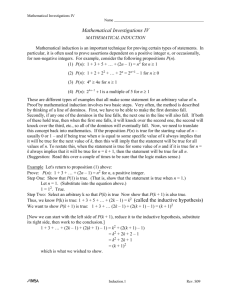drill
advertisement
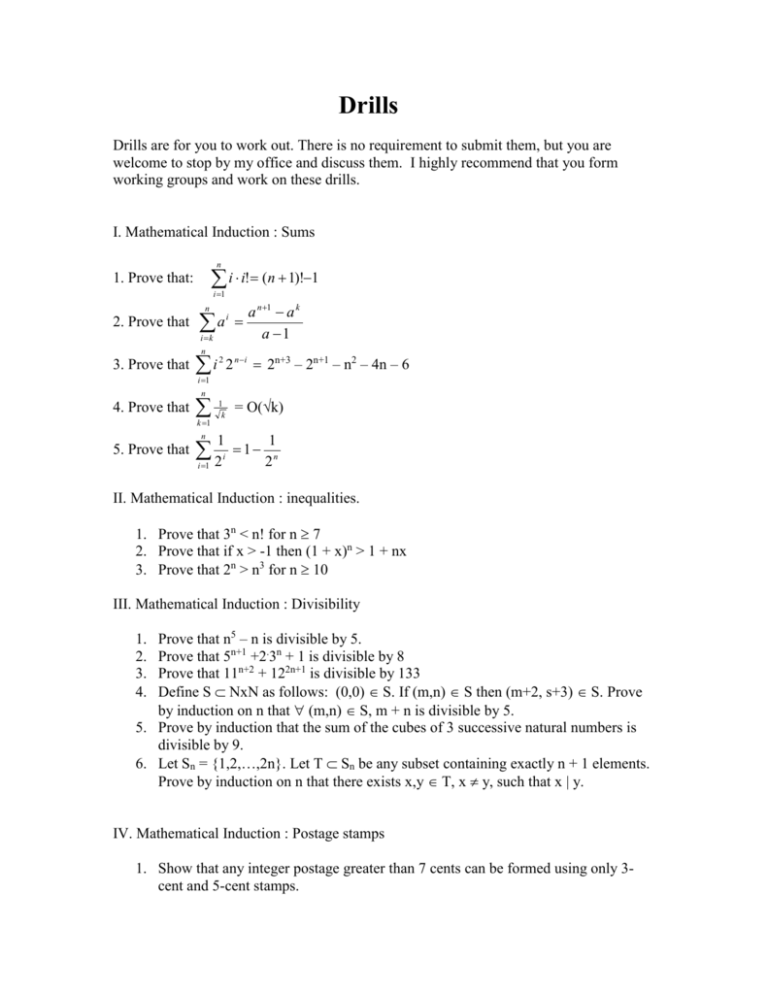
Drills
Drills are for you to work out. There is no requirement to submit them, but you are
welcome to stop by my office and discuss them. I highly recommend that you form
working groups and work on these drills.
I. Mathematical Induction : Sums
n
i i! (n 1)!1
1. Prove that:
i 1
a n1 a k
2. Prove that a
a 1
i k
n
i
n
3. Prove that
i
2
2 n i 2n+3 – 2n+1 – n2 – 4n – 6
i 1
n
4. Prove that
1
k
n
1
k 1
5. Prove that
2
i 1
i
= O(k)
1
1
2n
II. Mathematical Induction : inequalities.
1. Prove that 3n < n! for n 7
2. Prove that if x > -1 then (1 + x)n > 1 + nx
3. Prove that 2n > n3 for n 10
III. Mathematical Induction : Divisibility
Prove that n5 – n is divisible by 5.
Prove that 5n+1 +2.3n + 1 is divisible by 8
Prove that 11n+2 + 122n+1 is divisible by 133
Define S NxN as follows: (0,0) S. If (m,n) S then (m+2, s+3) S. Prove
by induction on n that (m,n) S, m + n is divisible by 5.
5. Prove by induction that the sum of the cubes of 3 successive natural numbers is
divisible by 9.
6. Let Sn = {1,2,…,2n}. Let T Sn be any subset containing exactly n + 1 elements.
Prove by induction on n that there exists x,y T, x y, such that x | y.
1.
2.
3.
4.
IV. Mathematical Induction : Postage stamps
1. Show that any integer postage greater than 7 cents can be formed using only 3cent and 5-cent stamps.
2. Show that any integer postage greater than 5 cents can be formed using only 2cent and 7-cent stamps.
3. Show that any integer postage greater than 59 cents can be formed using only 11cent and 7-cent stamps.
4. What is the smallest integer k such that any integer postage greater than k cents
can be formed by using 4-cent and 9-cent stamps? Prove your answer correct.
5. Show that for all n 1, any positive integer amount of postage n(n – 1) cents
can be formed by using only n-cent and (n + 1)-cent stamps.
V. Mathematical Induction : Fibonacci Numbers (f0 = 0, f1 = 1, fn = fn-1 + fn-2)
n
1. Prove that
f
i 0
2.
3.
i
f n2 1
Prove that fn+k = fk.fn+1 + fk-1.fn
Prove that for n 1 fn+1.fn+2 = fn.fn+3 = (-1)n
VI Mathematical Induction : Binomial coefficients.
2k 2k
1. Prove that > for k j.
k j
2k
2. Prove that = (22k/2k)
k
n
n
3. Prove that i n2n-1
i 1
i
VII Mathematical Induction : Miscellaneous
1. Let xy be the exclusive or. Prove that x1x2…xn is True if and only if an
odd numbers of x1,x2,…,xn are True.
2. The following Java method returns the k-th digit from the end of the integer n.
Prove its correctness by induction on k.
public static int getDig(int n, int k) {
if (k = = 1)
return n%10;
else
return getDig(n/10, k -1);
}
3. The following Java method returns the sum of the digits of the integer n. Prove its
correctness by induction.
public static int getDig(int n) {
if (n < 10)
return n;
else
return n%10 + getDig(n/10);
}
